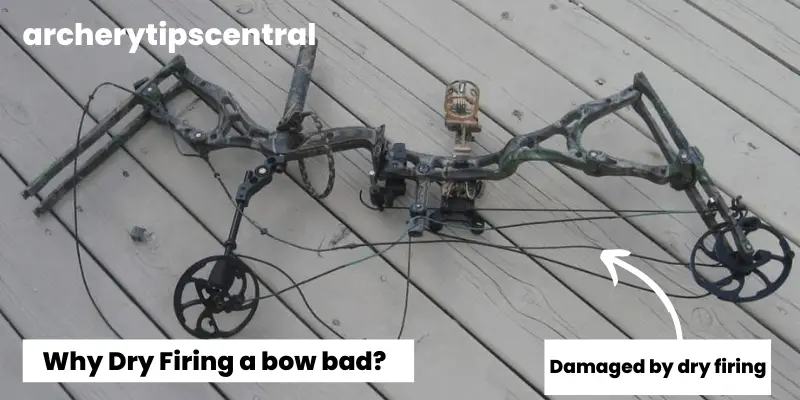In archery, dry firing a bow is not recommended, but it can be an accidental event if the bow is not properly secured.
Here the question is, why is dry firing a bow bad? Firstly, it can damage the bow’s limbs. Secondly, the bow can be yanked out of their hand or pulled back too hard, causing pain or even injury. Thirdly, dry firing makes it difficult to shoot accurately. Finally, dry firing can also cause a poorly-made bow to break.
I’m sharing essential information about dry firing, common problems, and other scenarios. Therefore let’s get started.
Table of Contents
- What is dry firing a bow?
- 6 Reasons why dry firing a bow is bad
- How to tell if a bow is damaged after a dry fire?
- Does dry firing a bow damage it?
- Is overdrawing a bow bad?
What is dry firing a bow?
In archery, dry firing occurs whenever the bowstring is pulled without an arrow, or the bow and arrow do not strike the bowstring right together. When fired, the bow normally releases up to 75 percent of energy, and its draw remains 100 percent even without meaning. This is a substantial safety risk.
So many people think completely dry fire is firing a bow without an arrow. But this phenomenon could also happen if the string refuses to work or the arrow is too weak.
Deep Dive: What Is Dry Firing A Bow In Archery?
6 Reasons why dry firing a bow is bad
Dry firing a bow is bad for your bow, arrow, and hand. Here are some reasons why.
#1. Weaken the bow’s string
Dry firing a bow can weaken the bow’s string over time. This is because the string is constantly stretched and pulled when the bow is not used. If you are worried about your bow’s string quality, it is recommended not to dry fire your bow and consistently maintain good arrow care habits.
#2. Damage to the bow’s limbs
Dry firing can cause damage to a bow’s limbs. Because the limbs and string are not fixed properly with each other when firing. This causes the string to vibrate and can eventually fracture the limb. And the bow’s limbs can become loose and out of alignment from dry firing.
#3. Damage to the arrow shaft
It can damage the arrows by breaking the shafts or causing them to fly off crookedly. Arrow shafts can become brittle from dry firing, leading to shattered tips or even an entire arrow shaft being lost.
#4. Damage your bow
Dry firing can cause wear and tear on the bow and its components. The bowstring can become overstretched, damaging the bow and causing headaches if not corrected. It can also cause a bow to break suddenly.
The bow can break if you use too much force when you dry fire it or if the bow is not adequately stabilized. The leather can be damaged if you dry fire the bow too often or if the bows are not properly stabilized.
#5. lose your accuracy
Dry firing can cause an archer to lose focus and accuracy. It can cause the bow to malfunction. It can make it harder to learn how to shoot a bow correctly. Finally, dry firing can lead to improper hand-eye coordination and muscle memory.
#6. Injure your hands and wrists
Bow strings can be cut by the bowstring’s hand when the bow is accidentally pulled to the full draw position, and it is the common cause of injury among archers.
A proper safety procedure includes securing the bow in a V-notch and ensuring that the string is not allowed to contact any part of the bow other than the limb tips.
Learn: How to fix a dry-fired bow?
How to tell if a bow is damaged after a dry fire?
If you accidentally dry-fire a bow, inspect the bowstring with a light and magnifying glass. Is it frayed, twisted, or kinked? Especially where the string connects to the wheels and cams.
And, also check near the axles. Pull on the string gently and see if it moves. If it doesn’t move, the bow is probably damaged. Move the light on the limbs of the bow to examine them. Check any cracks for splinters and limbs.
Shoot the bow with an arrow at your target and note anything peculiar or uncomfortable. If there are unusual vibrations or noise, Then you can ensure that the bubble is damaged after a dry fire.
Does dry firing a bow damage it?
Dry firing a bow can damage the bowstring, limb, cam, or other parts of the bow. A bow’s repeated dry firing causes the strings to stretch and ultimately break. so if you’re considering dry-firing your bow, consider using a prop or something else to hold it.
Is overdrawing a bow bad?
An overdraw helps shoot heavier and, therefore, faster arrows. This may allow you to possibly drop an updated version, meaning you could make your arrows lighter and achieve greater distances. But overdrawing might also negatively impact your choice.
An overdraw also affects your arrow spine. The more you shoot an overdraw with, the less sturdy your arrow spine gets. Adding up to 3 to 4 pounds of draw weight to your archery bow is the equivalent of increasing the overdraw by this amount.

